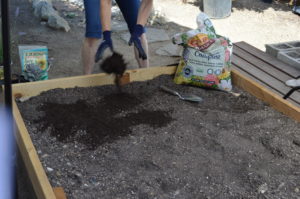Using Compost in Your Garden
 Compost is black gold in the garden. Created naturally from decayed organic matter such as leaves, grass clippings, food waste, and manure, compost offers so many benefits to the soil and, consequently, to plants. It adds slowly released nutrients as well as beneficial microbes to the soil. It also improves the structure of soil and helps it to retain water. Unsure what type of soil you have? Learn how to test your garden soil here. Using compost in the garden is an important part of sustainable and water-wise gardening.
Compost is black gold in the garden. Created naturally from decayed organic matter such as leaves, grass clippings, food waste, and manure, compost offers so many benefits to the soil and, consequently, to plants. It adds slowly released nutrients as well as beneficial microbes to the soil. It also improves the structure of soil and helps it to retain water. Unsure what type of soil you have? Learn how to test your garden soil here. Using compost in the garden is an important part of sustainable and water-wise gardening.
You can make your own compost at home, using your own garden and food waste, or if you don’t compost or need more compost than your home and garden can produce, then you can buy it by the bag or in bulk from your local nursery or garden center. Look for the “Certified Compost Seal of Testing Assurance” issued by the U.S. Composting Council so you’ll know the compost you buy has been tested and is safe, fully mature and ready to use, and that it does not contain anything that can inhibit plant growth. You can also find soil amendments that contain compost along with other organic ingredients such as worm castings or bat guano.
Here’s how you can put compost to use in your garden for the best results.
Prepare Vegetable and Flower Beds before Planting
Mixing three to four inches of compost into the soil two to four weeks before planting is the best way to prepare for planting. The organic matter in the compost attracts earthworms and spurs beneficial insects and microbes into action. As they incorporate the compost into the existing soil, they spread the nutrients and aerate the soil, building a better base to plant in.
Use Compost as Mulch
Compost can be spread as a layer up to four inches deep around flower and vegetable beds and it will provide the same benefits as other mulches, such as helping to suppress weeds, minimize evaporation, and moderate soil temperature.
Top-Dress Lawns
Give your established lawn a boost by spreading a light layer (no more than ½ inch) evenly over the grass and watering well.
Side-Dress Plants during the Growing Season
Provide a supplemental dose of nutrition to plants as they’re growing by adding up to three inches of compost around the base of plants. You don’t have to till the compost into the soil—water, earthworms, and other insects will do the work of incorporating it for you. But do be sure to avoid piling compost right up against woody stems and trunks, which can encourage crown rot.
Add to Potting Mixes for Indoor and Outdoor Container Plants
Mixing compost into potting mixes when planting in containers helps to increase microbial action that is important for healthy soil and refreshing houseplant soil by topping off with a couple inches of compost will help keep up aerobic activity that can become diminished with indoor growing conditions. Plus, your plants will benefit from the slow release of nutrients that feed the roots without the risk of shock that fertilizers can sometimes create.